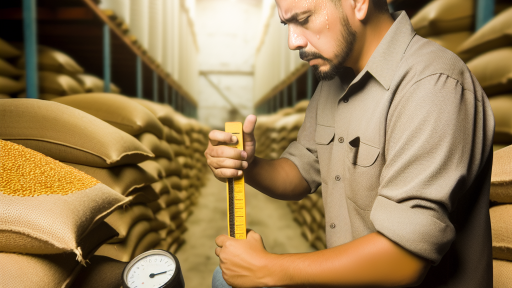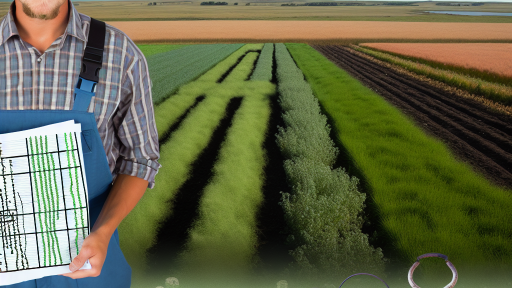Understanding Soil Organic Matter
Definition of Soil Organic Matter
Soil organic matter consists of decomposed plant and animal materials.
It also includes microbes and their byproducts.
These components enhance soil health and fertility.
Organic matter can be found in various forms within the soil.
It plays a crucial role in nutrient cycling.
Importance of Soil Organic Matter
Soil organic matter significantly improves soil structure.
Healthy soil structure enhances water retention and drainage.
Furthermore, it helps prevent soil erosion.
Additionally, organic matter boosts microbial activity.
This activity is vital for breaking down organic materials.
Benefits of Building Soil Organic Matter
Increasing soil organic matter promotes higher crop yields.
Healthy soils require fewer chemical fertilizers.
This leads to lower production costs for farmers.
Moreover, rich organic matter improves the soil’s ability to store carbon.
This can help mitigate climate change effects.
Transform Your Agribusiness
Unlock your farm's potential with expert advice tailored to your needs. Get actionable steps that drive real results.
Get StartedEnhancing Soil Fertility
Soil organic matter improves nutrient availability for plants.
It acts as a reservoir for essential nutrients.
Farmers benefit from increased soil fertility through better harvests.
Contributing to Environmental Health
By building organic matter, farmers support biodiversity.
Healthy soils also reduce chemical runoff into waterways.
This practice fosters environmental sustainability.
Benefits of Increasing Soil Organic Matter for Crop Yield
Improved Soil Structure
Increasing soil organic matter enhances soil structure significantly.
This improvement allows better water infiltration and retention.
Additionally, it creates a stable environment for beneficial microorganisms.
Enhanced Nutrient Availability
Organic matter plays a crucial role in nutrient cycling.
It increases the availability of essential nutrients to crops.
Furthermore, it enhances the soil’s cation exchange capacity.
Improved Water Retention
Higher levels of organic matter improve water retention in the soil.
This is particularly beneficial during dry periods.
Moreover, it helps reduce irrigation needs over time.
Increased Biodiversity
Soil rich in organic matter supports a diverse ecosystem.
This diversity enhances soil health and resilience.
As a result, it reduces the need for chemical fertilizers and pesticides.
Greater Crop Resilience
Healthy soil contributes to increased crop resilience against stressors.
Crops thrive better in well-structured, nutrient-rich soil.
This leads to improved yield and quality of produce.
Lower Input Costs
Investing in organic matter can lower long-term agricultural inputs.
With improved soil health, farmers may require less fertilizer.
This ultimately increases profitability for farming operations.
Showcase Your Farming Business
Publish your professional farming services profile on our blog for a one-time fee of $200 and reach a dedicated audience of farmers and agribusiness owners.
Publish Your ProfileEnvironmental Benefits
Building soil organic matter enhances carbon sequestration.
This process mitigates climate change effects significantly.
It also promotes healthier surrounding ecosystems through sustainable practices.
Methods for Building Soil Organic Matter
Composting Techniques
Composting represents a vital practice for building soil organic matter.
This process transforms organic waste into nutrient-rich compost.
Farmers can efficiently reduce waste while enhancing soil health.
Choosing the Right Materials
Selecting diverse materials for compost is essential.
Include kitchen scraps, yard waste, and agricultural residues.
A balance of carbon-rich and nitrogen-rich materials is crucial.
Carbon sources include dry leaves, straw, and cardboard.
Nitrogen sources consist of fresh grass clippings, food scraps, and manure.
Layering for Optimal Decomposition
Layering materials in the compost bin promotes airflow.
Start with coarse materials at the bottom to enhance drainage.
Alternate layers of green and brown materials for balance.
This structure aids in efficient breakdown and heating.
Maintaining Moisture Levels
Moisture plays a significant role in composting efficiency.
The compost pile should feel like a damp sponge.
Add water if the pile appears dry or overly compacted.
Conversely, aeration may be needed if it becomes too wet.
Aeration Techniques
Aeration enhances the aerobic process within the compost pile.
Turn the pile regularly with a pitchfork for best results.
Introduce air pockets by mixing in coarse materials.
This action promotes faster decomposition and reduces odors.
Timeframe for Composting
The composting process can vary based on materials and conditions.
Typically, composting takes from two months to a year.
Monitor the temperature to ensure optimal microbial activity.
Use a thermometer to check for sufficient heat generation.
Using Finished Compost
Finished compost enriches soil with organic matter.
Apply a layer of compost to garden beds and around plants.
This practice improves soil structure and moisture retention.
It also provides essential nutrients for plant growth.
Gain More Insights: Data Analysis Tools For Disease Forecasting In Farming
Cover Crops: Types to Enhance Soil Organic Matter
Importance of Cover Crops
Cover crops play a vital role in building soil organic matter.
They help improve soil structure and enhance fertility.
Moreover, cover crops can prevent soil erosion and suppress weeds.
Types of Cover Crops
Several types of cover crops can boost soil organic matter levels.
Choosing the right type depends on specific farming goals.
Leguminous Cover Crops
Leguminous crops like clover and vetch add nitrogen to the soil.
They fix atmospheric nitrogen, enriching the soil naturally.
Consequently, these crops enhance microbial activity in the soil.
Showcase Your Farming Business
Publish your professional farming services profile on our blog for a one-time fee of $200 and reach a dedicated audience of farmers and agribusiness owners.
Publish Your ProfileGrasses as Cover Crops
Grasses such as rye and oats are excellent for soil cover.
They provide ground cover to reduce erosion and runoff.
In addition, grasses improve soil structure through root systems.
Brassica Family Cover Crops
Brassicas like turnips and radishes have unique benefits.
They can break compacted soil layers and improve drainage.
Furthermore, these crops contribute organic matter upon decomposition.
Implementing Cover Crops
Successful incorporation of cover crops requires proper planning.
Farmers should select cover crops based on the cropping system.
Timing of planting and termination is also crucial for success.
Intercropping with Cash Crops
Intercropping cover crops with cash crops maximizes benefits.
This method enhances biodiversity and soil cover simultaneously.
Moreover, it can lead to improved overall farm productivity.
Utilizing Crop Rotations
Crop rotations with cover crops ensure nutrient cycling.
This practice helps reduce pest and disease pressures over time.
Diverse rotations lead to healthier soil ecosystems.
Challenges and Considerations
While benefits are substantial, challenges may arise with cover crops.
Farmers must consider the cost and availability of seeds.
Managing cover crop growth without interfering with main crops is essential.
Additionally, understanding local climate conditions is critical.
See Related Content: Benefits Of Accurate Disease Forecasting For Farmers
Crop Rotation Strategies and Their Impact on Soil Health
Defining Crop Rotation
Crop rotation involves changing the type of crops grown in a specific area each season.
This practice improves soil health and nutrient content over time.
Farmers use it to disrupt pest cycles and enhance biodiversity.
Also, rotating crops prevents soil degradation and promotes sustainability.
Benefits of Crop Rotation
One major benefit is the enhancement of soil fertility.
Diverse crops contribute different nutrients back to the soil.
For instance, legumes add nitrogen, benefiting subsequent crops.
Additionally, rotating crops can reduce the build-up of pests and diseases.
Farmers notice fewer infestations when they alternate plant families.
Common Crop Rotation Patterns
Many farmers implement specific crop rotation patterns for maximum effectiveness.
One common strategy is the three-crop rotation: corn, soybeans, and wheat.
Another method includes planting cover crops during off-seasons.
These practices promote soil cover and prevent erosion.
Integrating Crop Rotation with Other Practices
Farmers often combine crop rotation with no-till farming.
This combination helps maintain soil structure and moisture levels.
Moreover, integrating organic matter additions increases soil organic content.
These holistic approaches contribute significantly to soil health.
Challenges of Crop Rotation
Despite its benefits, crop rotation does present challenges.
Farmers may struggle to find compatible crops for rotation.
Additionally, market demands can influence crop choices.
Showcase Your Farming Business
Publish your professional farming services profile on our blog for a one-time fee of $200 and reach a dedicated audience of farmers and agribusiness owners.
Publish Your ProfileFor successful implementation, careful planning is crucial.
Uncover the Details: Hydroponics Systems Explained

The Role of Microorganisms in Soil Organic Matter Formation
Understanding Soil Microorganisms
Soi microorganisms include bacteria, fungi, and protozoa.
These tiny organisms play a vital role in soil health.
They break down organic matter into simpler compounds.
Thus, they contribute to soil organic matter formation.
Decomposing Organic Matter
Microorganisms initiate the decomposition process.
They consume dead plant and animal materials.
In doing so, they release nutrients back into the soil.
This process enhances soil fertility.
Forming Humus
Microorganisms also aid in converting organic matter into humus.
Humus improves soil structure and water retention.
Additionally, it supports nutrient storage for plants.
As a result, healthy soils promote robust crop growth.
Enhancing Soil Biodiversity
The activities of microorganisms improve soil biodiversity.
They interact with plants to create a symbiotic relationship.
This relationship increases nutrient uptake for crops.
Moreover, diverse microbial communities strengthen ecosystem resilience.
Influencing Soil Chemistry
Microorganisms play a key role in nutrient cycling.
They transform nitrogen, phosphorus, and sulfur into usable forms.
This transformation is essential for plant growth and health.
Consequently, healthy soils lead to improved agricultural yields.
Promoting Soil Structure
The presence of microorganisms fosters soil aggregation.
Soil aggregates improve aeration and water infiltration.
Additionally, they protect against erosion.
This protection is crucial for maintaining productive farmland.
Learn More: Precision Agriculture Techniques For Disease Forecasting
Innovative Technologies for Monitoring Soil Organic Matter Levels
Advanced Soil Sensors
Advanced soil sensors provide real-time data on organic matter levels.
These sensors utilize electrical conductivity to measure soil properties.
Farmers can deploy these devices across their fields for full coverage.
This technology helps optimize management practices effectively.
Drones for Soil Analysis
Drones equipped with multispectral cameras survey large areas quickly.
They capture images that reveal soil health and organic matter distribution.
The data collected can inform targeted interventions on the farm.
Drones enhance the efficiency of traditional soil sampling methods.
Data Analytics and Machine Learning
Data analytics applications process soil organic matter data efficiently.
Machine learning algorithms analyze patterns and predict trends.
This technology allows farmers to make data-driven decisions.
By harnessing analytics, they can enhance soil health management.
Mobile Applications for On-the-Go Monitoring
Mobile apps now offer soil monitoring solutions directly to farmers.
Showcase Your Farming Business
Publish your professional farming services profile on our blog for a one-time fee of $200 and reach a dedicated audience of farmers and agribusiness owners.
Publish Your ProfileThese applications provide access to soil data anytime and anywhere.
Farmers can track changes in organic matter levels effortlessly.
Moreover, they receive tailored recommendations based on their specific data.
Remote Sensing Technologies
Remote sensing uses satellite imagery to monitor soil conditions.
This method tracks changes in organic matter over large landscapes.
Farmers gain insights into crop health and soil management practices.
Consequently, they can adjust their strategies based on real-time information.
Common Challenges and Solutions in Building Soil Organic Matter
Understanding Soil Organic Matter
Soyl organic matter (SOM) is crucial for healthy soil ecosystems.
It improves soil structure and water retention.
Furthermore, it enhances nutrient availability for plants.
Common Challenges Faced by Farmers
Farmers often struggle with soil degradation.
Intensive farming practices contribute to this issue.
Additionally, lack of awareness about SOM’s importance is prevalent.
Implementing Cover Crops
Cover crops can significantly boost soil organic matter.
They prevent erosion and improve soil structure.
Moreover, they fix nitrogen in the soil.
Farmers can choose legumes, grasses, or brassicas as cover crops.
Utilizing Compost and Manure
Composting provides rich organic matter for the soil.
Farmers can recycle waste materials effectively.
Likewise, manure enhances nutrient content in the soil.
It’s essential to manage application rates to prevent runoff.
Adopting Reduced Tillage Practices
Reducing tillage mitigates soil disturbance.
This practice helps retain soil structure and moisture.
Moreover, it fosters the growth of beneficial microorganisms.
Enhancing Crop Rotation Strategies
Crop rotation can enhance soil fertility over time.
Farmers can alternate deep-rooted and shallow-rooted plants.
This method helps in the efficient use of soil nutrients.
Additionally, it disrupts pest cycles and reduces erosion.
Monitoring Soil Health Regularly
Regular soil testing identifies nutrient deficiencies.
Farmers can adjust practices based on test results.
Moreover, monitoring helps track improvements in soil organic matter.
Building Local Knowledge Networks
Engaging with local agricultural communities is beneficial.
Sharing experiences and practices fosters innovation.
Farmers can learn successful strategies from one another.
Diverse perspectives can lead to more effective solutions.




